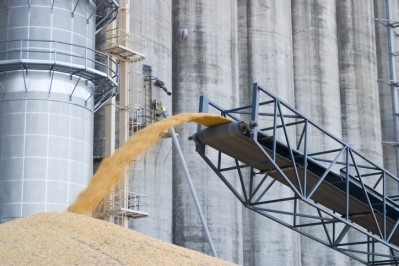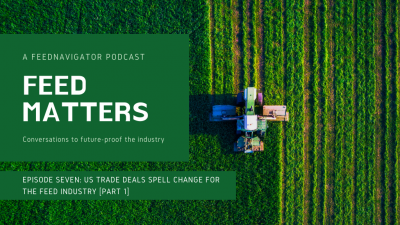Predictions for 2019: Gazing into the US feed industry’s crystal ball

Tom Sleight, president and CEO with the US Grains Council (USGC), is hoping to see some changes in how trade is discussed.
“We’d like to see trade not become as politicized as much as it became in 2018 so that we get down to deal-making and looking at these tariffs and looking at access and things like that, and hopefully engaging in a less political fashion,” he told FeedNavigator.
“We’d like to see that because trade is so important for agriculture.”
The council will be watching the progress of the US, Mexico, Canada Agreement (USMCA) through Congress, he said.
Trade votes can be challenging, and the agreement would be positive for the coarse grains sector.
“Perhaps, in the end, they will realize that it’s in the best interest of the US and let it get ratified, that’s my hope,” he said. “But in the contentious world we live in now, it will be an interesting and long ride for ratification.”
As efforts continue to have trade discussions with Japan and the EU, there could be some contentious topics, said Sleight. However, the council is hoping that navigating those discussions will be less challenging than the initial efforts for the NAFTA renegotiation process.
On the trade side, the goal will be to expand and “ramp up” demand for products and push for greater momentum in Africa while supporting demand in other countries, he said. “We want to see that we’ve got new demand drivers,” he added.
“I would hope that we’d be seeing some sort of lessening of concerns on trade policy – the antidumping, countervailing duty things we’ve had a strong go with that lately,” he said. “I hope some of those start to work through the system and that people start to understand the role that trade can play in meeting food production needs and fuel production needs.”
The coming year may be time to increase the council’s presence in India and across Southeast Asia, along with giving more attention to efforts in Central and South America, he said.
Feed industry opportunities in 2019
Looking into 2019, improving trade with China remains a priority, said Leah Wilkinson, VP of public policy and education, American Feed Industry Association (AFIA).
“Progress with China would be the continued reduction of trade barriers and the ability to have our governments start taking again, and being able to get these requirements done with decree 118 and the facility audits,” she told us.
However, the association also is watching the progress of other trade deals including the USMCA passage through Congress and work on a potential bilateral trade agreement with Japan, she said. “We’ve got the opportunity in 2019 on the trade side,” she added.
“Japan is our third largest market for our industry so that one is very important to us,” said Wilkinson. “We recently put in some comments to the US Trade Representative on the importance of that potential bilateral for our industry and the same for Europe and UK – those are both potential good opportunities for us.”
There are challenges with the EU market, she said, which is prompting AFIA to push for any trade negotiations there to include agriculture.
“We don’t want to see it done piecemeal – we don’t want to see them do a partial agreement saying they’ll come back to agriculture later,” she said. “We want to be in there from the get-go and I think you’ll hear that from all of agriculture.”
In addition to trade, the AFIA is set to continue working on its partnership with the US swine industry regarding African Swine Fever (ASF) prevention, said Wilkinson.
“We’ll continue to look for ways we can help educate [stakeholders] on how our industry works – why we have to import certain ingredients; how they’re manufactured; and the ability for us to use our charity, the Institute for Feed Education and Research (IFEEDER), to help fund some research to help get more data points on potential mitigation,” she said. “In the meantime, we are looking at the biosecurity practices that we have in place and will be updating those soon and getting them out to the industry.”
Feed crop production
On the feed crop production side, the coming planting year could bring some challenges for producers in terms of supply, said David Widmar, agricultural economist. Previously, when wheat prices were low acreage changed to add additional production of other feed and grain crops and that pattern may be repeating with soybeans.
“Wheat acres turned higher last year that’s a signal that conditions improved in wheat – now the dumpster fire is moved into soybeans,” he told us.
There is expected to be a shift out of soybeans, however, the question becomes how much will move into corn production, he said.
“If cotton and wheat don’t pick up the slack, then it’s a one-to-one trade, corn to soybeans,” he added.
“Step one is to see how many acres of winter wheat were planted this year – I was expecting it to be higher, I didn’t expect it to be fewer based on economics … it could come in lower, and then we have to watch spring wheat acres,” he said. Adding, “and then keep an eye on cotton, and then we have to figure out how the other crops will change – if we see a bump in wheat and cotton [that] takes some of the pressure off of corn and soybeans.”
“What the corn market is looking at is we’re going to have more acres, and they’re looking at an oversupply issue in 2019,” said Widmar. “Soybeans are going to export their problems to corn as well as wheat and cotton as we recalibrate the acreage portfolio.”
On the feed buying side, there is added uncertainty in the market, he said. “We’ve been telling producers because of all this extra uncertainty know the cost of your production, know what you need, know the financial goals and when an opportunity presents itself take advantage of that opportunity,” he added.
“If you’re in a situation where you know from your cost of production that you can buy feed today and it works for the economics of your business, [then] it’s a time in history you might want to lock that in and take some of that risk off the table,” he said. “There’s more risk than you might be used to – if you could measure risk, we’re probably in a high-risk environment historically speaking.”
Organic perspectives
For feed producers working in the organic sector areas of focus for the new year include on-going work to establish a voluntary checkoff program and to reduce fraud in organic feed grain imports, said Laura Batcha, CEO and executive director with the Organic Trade Association (OTA).
“The Organic Trade Association in late November submitted comments to USDA outlining its top ten priorities for boosting the integrity of the global organic market,” she told FeedNavigator.
“The purpose of filing the comments now was to help shape a set of proposed rules that the National Organic Program (NOP) will publish in spring 2019 to strengthen the oversight and enforcement of organic regulations,” she added. “NOP is calling the rules its Strengthening Organic Enforcement rulemaking, envisioned to be one of the largest pieces of single rulemaking in the history of NOP.”
The association also is focusing on efforts outlined by the Organic Grains Collaboration to expand US production of feed grains, she told us.
The OTA will be working with the USDA to implement the organic provisions from the Farm Bill, which was signed into law Thursday [December 20].












